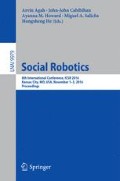Abstract
Educational robots are regarded as beneficial tools in education due to their capabilities of improving learning motivation. Using cognitive dissonance as a teaching tool has been popular in science education too. A considerable number of researchers have argued that cognitive dissonance has an important role in the student’s attitudes change. This paper presents a design for a cutting-edge experiment where we describe a procedure that induces cognitive dissonance. We propose to use an educational robot that helps the student overcome the cognitive dissonance during science learning. We make the difference between students that base their decisions on thinking (though-minded) and those that mostly base their decisions on feeling (relational). The main mission of the study was to implicitly lead students to evolve a positive implicit attitude supporting redoing difficult scientific exercises to understand one’s errors and to avoid learned helplessness. Based on the assumption that relational students are emotional (easily alienated), we investigate whether they are easy to be persuaded in comparison to though-minded students. Also, we verify whether it is possible to consider an educational robot for such a mission. We compare different persuasive sources (tablet showing a persuasive text, an animated robot and a human) encouraging the student to strive for cognitive closure, to verify which of these sources leads to better implicit attitude supporting defeating one’s self to assimilate difficult scientific exercises. Finally, we explore which of the persuasive sources better fits each of both student’s profiles.
Access this chapter
Tax calculation will be finalised at checkout
Purchases are for personal use only
Notes
- 1.
- 2.
- 3.
The student will avoid science learning.
- 4.
The student thinks that he has to change his attitude of avoiding difficult exercises.
- 5.
After all, science learning is not that important. Many other tasks could be done.
- 6.
The student thinks that the answer afforded by the book is incorrect.
- 7.
By measuring the implicit and explicit attitudes, we can verify whether it was established for a long term basis.
- 8.
Typical errors in human social judgment that are caused by systemic use of cognitive strategies.
- 9.
In decision-making, the weight given to possible losses is greater than possible gains.
- 10.
- 11.
This is to measure the student’s explicit attitude. We just ask respondents to think about and report their attitudes.
- 12.
Forewarning often produces resistance to persuasion.
- 13.
By debriefing the students. In fact, psychologists usually think of explicit measures as those that require respondents’ conscious attention to the construct being measured by using Likert scale and semantic differential scale (it is the planned behavior in our case).
- 14.
This is important to verify whether the student is convinced about the fact that he needs to strive for science learning by redoing difficult exercises rather than adopting a negative implicit attitude that supports learned helplessness. Implicit measures are those that do not require this conscious attention (spontaneous behavior). Some methods could help to measure the implicit attitude such as evaluative priming and the implicit association test.
- 15.
This is to measure the cognitive dissonance level according to the student’s subjective evaluation.
- 16.
References
Han, J., Kim, D.: r-learning services for elementary school students with a teaching assistant robot. In: Conference on Human Robot Interaction, pp. 255–256 (2009)
Robins, B., Dautenhahn, K.: Tactile interactions with a humanoid robot: novel play scenario implementations with children with autism. J. Soc. Robot. 6, 397–415 (2014)
Billard, A.: Robota: clever toy and educational tool. Robot. Auton. Syst. 42, 259–269 (2003)
Kanda, T., Sato, R., Ishiguro, H.: A two-month field trial in an elementary school for long-term human-robot interaction. IEEE Trans. Robot. 23, 962–971 (2007)
Zhen, Y., Chi, S., Chih, C., Gwo-Dong, C.: A robot as a teaching assistant in an English class. In: Conference on Advanced Learning Technologies, pp. 87–91 (2006)
Abramason, L.Y., Seligman, M.E., Teasdale, J.D.: Learned helplessness in humans: critique and reformulation. J. Abnorm. Psychol. 87, 49–74 (1978)
Murray, A., James, M., Scott, L.: Psychopathic personality traits and cognitive dissonance: individual differences in attitude change. J. Res. Pers. 46, 525–536 (2012)
Pantos, A.J.: Measuring implicit and explicit attitudes toward foreign-accented speech. J. Lang. Soc. Psychol. 32, 3–20 (2013)
Levin, D., Harriott, C., Natalie, A.P., Julie, A.A.: Cognitive dissonance as a measure of reactions to human-robot interaction. J. Hum. Robot Interact. 2, 3–17 (2013)
Author information
Authors and Affiliations
Corresponding author
Editor information
Editors and Affiliations
Rights and permissions
Copyright information
© 2016 Springer International Publishing AG
About this paper
Cite this paper
Youssef, K., Ham, J., Okada, M. (2016). Investigating the Effects of the Persuasive Source’s Social Agency Level and the Student’s Profile to Overcome the Cognitive Dissonance. In: Agah, A., Cabibihan, JJ., Howard, A., Salichs, M., He, H. (eds) Social Robotics. ICSR 2016. Lecture Notes in Computer Science(), vol 9979. Springer, Cham. https://doi.org/10.1007/978-3-319-47437-3_12
Download citation
DOI: https://doi.org/10.1007/978-3-319-47437-3_12
Published:
Publisher Name: Springer, Cham
Print ISBN: 978-3-319-47436-6
Online ISBN: 978-3-319-47437-3
eBook Packages: Computer ScienceComputer Science (R0)

